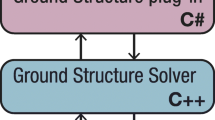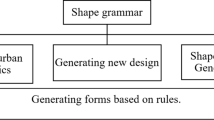Abstract
The energy consumption of a building and its internal conditions are intimately related to its shape. There have been various attempts to use computer-based optimisation within a thermal simulation environment to produce designs with minimal energy consumption. Most of these studies have looked at optimising parameters such as U-values and glazing ratios, but a small number have looked into the form of the building, but in a way that does not naturally fit with the human-led design process. In this paper, the first practical methodology for optimising complex building facades and internal layouts is presented. The method allows for a free exploration of new, non-preconceived, design solutions in a way that complements the natural design process. The method has been tested on a design with eight facades. The rapid convergence of glazing ratios for all runs indicates their significance in the energy performance of a building. The solutions display a high degree of variability of floor shape without a compromise in performance, which indicates that human judgment can still be used as a filter even within an optimising framework. Typical solutions produced by the method show an annual total energy demand of 56 kWh/m2, 51% lower than typical for the region in which the building was sited.
Similar content being viewed by others
References
AIA (2011). Defining the Architect’s Basic Services. Available at http://www.aia.org/aiaucmp/groups/ek_members/documents/pdf/aiap026834.pdf. Accessed 20 Apr 2012.
Bouchlaghem N (2000). Optimising the design of building envelopes for thermal performance. Automation in Construction, 10: 101–112.
Caldas GL, Norford KL (2002). A design optimisation tool based on a genetic algorithm. Automation in Construction, 11: 173–184.
Chouchoulas O (2003). Shape evolution: An algorithmic method for conceptual architectural design combining shape grammars and genetic algorithms. PhD Thesis, University of Bath, UK.
Chronis A, Turner A, Tsigkari M (2011). Generative fluid dynamics: Integration of fast fluid dynamics and genetic algorithms for wind loading optimisation of a free form surface. In: Proceedings of 2011 Symposium on Simulation for Architecture and Urban Design, Boston, USA.
Coley DA, Winters D (1997). Genetic algorithm search efficacy in aesthetic product spaces. Complexity, 3: 23–27.
Coley DA (1999). An Introduction to Genetic Algorithm for Scientists and Engineers. Singapore: World Scientific Publishing.
Coley DA, Schukat S (2002). Low-energy design: Combining computer-based optimisation and human judgement. Building and Environment, 37: 1241–1247.
Crawley DB, Lawrie LK, Winkelmann FC, Buhl WF, Huang YJ, Pedersen CO, Strand RK, Liesen RJ, Fisher DE, Witte MJ, Glazer J (2001). EnergyPlus: Creating a new-generation building energy simulation program. Energy and Buildings, 33: 319–331.
Deb K (2001). Multi-Objective Optimization Using Evolutionary Algorithms. Chichester, UK: John Wiley & Sons.
Elezkurtaj T, Franck G (2001). Evolutionary Algorithms in Urban Planning. In: Proceedings of CORP 2001, Vienna, Austria, pp. 269–272.
Fry B, Reas C (2012). Overview: A Short Introduction to the Processing Software and Projects from the Community. Available at http://processing.org/about. Accessed 20 Apr 2012.
Gianni Botsford Architects (2005). Light House. Available at http://www.giannibotsford.com/project/light-house. Accessed 19 Apr 2012.
Goldberg DE (1989). Genetic Algorithms in Search, Optimization, and Machine Learning. Reading, UK: Addison-Wesley.
Holland J (1975). Adaptation in Natural and Artificial Systems: An Introductory Analysis with Applications to Biology, Control and Artificial Intelligence. Ann Arbor, USA: The University of Michigan Press.
Holst JN (2003). Using whole building simulation models and optimizing procedures to optimise building envelope design with respect to energy consumption and indoor environment. In: Proceedings of 8th International IBPSA Conference, Eindhoven, the Netherlands.
Kawakita G (2008). Environmental optimisation methods in sustainable design process: In combination with evolution-based digital technology. Master Thesis, Oxford Brookes University, UK.
Kohonen J (1999). A Brief Comparison of Simulated Annealing and Genetic Algorithm Approaches. Department of Computer Science, University of Helsinki, Finland.
Kolarevic B (2000). Digital morphogenesis and computational architectures. In: Proceedings of 4th SiGRaDi Conference, Rio de Janeiro, Brazil.
LBNL (2010). Input Output Reference: The Encyclopedic Reference to EnergyPlus Input and Output. Enrest Orlando Lawrence Berkely National Laboratory, USA.
Marks W (1997). Multicriteria optimisation of shape of energy-saving buildings. Building and Environment, 32: 331–339.
Mitchell M (1998). An Introduction to Genetic Algorithms. Cambridge, UK: The MIT Press.
Peippo K, Lund PD, Vartiainen E (1999). Multivariate optimisation of design trade-offs for solar low energy buildings. Energy and Buildings, 29: 189–205.
Ramallo-González, AP, Coley DA (2014). Using self-adaptive optimisation methods to perform sequential optimisation for low-energy building design. Energy and Buildings, 81: 18–29.
Rosenman MA, Gero J (1999). Evolving Designs by Generating Useful Complex Gene Structures. In: Bentley P (ed), Evolutionary Design by Computers. San Francisco: Morgan Kaufman.
Schlegel A (2012). controlP5: A GUI (Graphical User Interface) Library for Processing. Available at http://www.sojamo.de/libraries/controlP5. Accessed 16 May 2012.
Stiny G, Gips J (1972). Shape grammars and the generative specification of painting and sculpture. In: Freiman VC (ed), Proceedings of IFIP Congress 71, Amsterdam: North-Holland Publishing Company.
Tuhus-Dubrow D, Krarti M (2010). Genetic-algorithm based approach to optimize building envelope design for residential buildings. Building and Environment, 45: 1574–1581.
Turrin M, Buelow P, Stouffs R (2011). Design explorations of performance driven geometry in architectural design using parametric modelling and genetic algorithms. Advanced Engineering Informatics, 25: 656–675.
U.S. Department of Energy (2012). Weather Data. Available at http://apps1.eere.energy.gov/buildings/energyplus/cfm/weather_data3.cfm/region=2_asia_wmo_region_2/country=CHN/cname=China. Accessed 8 Jun 2012.
Wang W, Rivard H, Zmeureanu, R (2006). Floor shape optimisation for green building design. Advanced Engineering Informatics, 20: 363–378.
Watanabe S (2000). The IIIrd Generation of THE INDUCTION CITIES/INDUCTION DESIGN: Web Frame/Program Generated Architecture. Available at http://www.makoto-architect.com/idc2000/index2.htm. Accessed 15 May 2012.
Wetter M, Wright J (2004). A comparison of deterministic and probabilistic optimisation algorithms for nonsmooth simulation-based optimisation. Building and Environment, 39: 989–999.
Wetter M (2005). BuildOpt-A new building energy simulation program that is built on smooth models. Building and Environment, 40: 1085–1092.
Wright J, Mourshed M (2009). Geometric optimisation of fenestration. In: Proceedings of 11th International IBPSA Conference, Glasgow, UK.
Xie D, Zhang G, Zhou J, Zhang Q (2007). Analysis of building energy efficiency strategies for the hot sumber and cold winter zone in China. In: Proceedings of 10th International IBPSA Conference, Beijing, China.
Zhou G, Ihm P, Krarti M, Liu S, Henze GP (2003). Integration of an internal optimisation module within EnergyPlus. In: Proceedings of 8th International IBPSA Conference, Eindhoven, the Netherlands.
Author information
Authors and Affiliations
Corresponding author
Rights and permissions
About this article
Cite this article
Weng, Z., Ramallo-González, A.P. & Coley, D.A. The practical optimisation of complex architectural forms. Build. Simul. 8, 307–322 (2015). https://doi.org/10.1007/s12273-014-0208-1
Received:
Revised:
Accepted:
Published:
Issue Date:
DOI: https://doi.org/10.1007/s12273-014-0208-1




